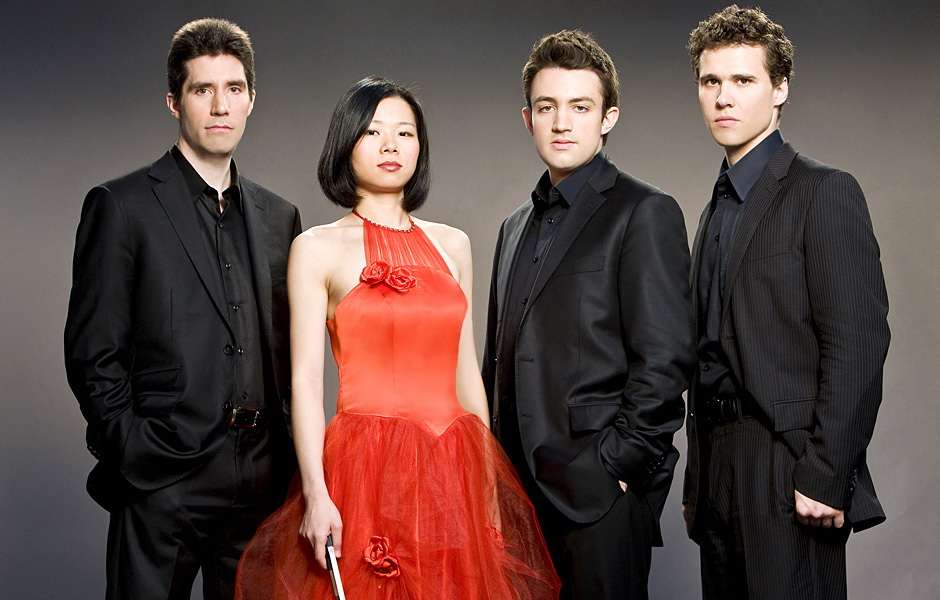|
Back
Escher Plays to Emotions Cincinnati
Robert J. Werner Recital Hall
01/18/2011 -
Antonín Dvorák: String Quartet No. 13 in G Major, Op. 106
Leos Janácek: String Quartet No. 2, Listy důvĕrné
Alexander von Zemlinsky: String Quartet No. 3, Op. 19
Escher String Quartet: Adam Barnett-Hart, Wu Jie (violin), Pierre Lapointe (viola), Dane Johansen (cello)

The Escher String Quartet (© ESQ)
Whether love, grief, joy or something else, the musicians of the Escher String Quartet brought feelings vividly to life for their Cincinnati audience with this program of late 19th and early 20th-century music. Giving it another kind of unity, all three works were composed in Prague within 33 years, during the transition from late romanticism to 20th-century modernism.
Baring their emotions through the dedicated performance of the young quartet – resident ensemble of Chamber Music Society of Lincoln Center’s “CMS” Two” program – were Antonín Dvorák, Leos Janácek and Alexander von Zemlinsky. Each work was given a brief spoken introduction by one of the players.
Janácek’s “muse” late in life, the much younger, married Kamila Stösslová, inspired his Quartet No. 2. It was his “testament to love,” explained cellist Dane Johansen. Subtitled Listy důvĕrne (Intimate Letters) by Janácek himself, it was composed in 1928, just before he died at 74. Janácek’s love was the painful, unrequited kind, though it fueled an unparalleled burst of creativity during his last years, and he and Kamila exchanged over 700 letters (Stösslová was also with him when he died). The four movements have no explicit program, said Johansen, but Janácek left hints in his letters. Thus, the opening Andante represents his first meeting with Kamila at a spa in 1917 (she was 25, he 63), the third movement the child he longed to have with her, the finale a kind of make-believe, “happily ever after.”
The viola represents Kamila, a role violist Pierre Lapointe carried out with richly varying tone color and expression. His sul ponticello entrance in the Andante (played on the bridge of the instrument) was like a spirit suddenly appearing before the composer’s eyes, while trills, rapid arpeggios and fragmentary episodes gave the players ample opportunity to express the rush of passion depicted in the music.
There was pain in the Adagio – violinist Wu Jie’s downward whole-tone flutters said it all – but also ardor, as captured in violinist Adam Barnett-Hart’s high-lying lines. The lullaby-like third movement (Moderato) had both melting tenderness and an almost goofy aspect, as giddy episodes succeeded more “serious” ones. Barnett-Hart led off the finale with a cheery, dance-like theme. There was romancing in thirds among the instruments and even a spirit of rejoicing in Wu Jie and Jacobsen’s big pizzicato chords, while Lapointe’s expressive solos lent more than a hint of mutual love.
Zemlinsky’s Quartet No. 3 was written in 1924 following his sister Mathilde’s death. A complex of emotions was captured here: grief, including the stiff-upper-lip kind mixed with sardonic humor, and some back-biting at his friend Arnold Schoenberg (Mathilde’s husband, who re-married before the official year of mourning was over). Violist Lapointe described it as a “requiem” for Mathilde, but also pointed out how Zemlinsky poked fun at Schoenberg’s 12-tone method (which Zemlinsky never adopted) and used a motto-theme for his own name. Playing was precise throughout -- remarkably so in the rapid pizzicato passages early in the Theme and Variations movement. There was an elegiac feel to the Romanze and lots of light-heartedness in the Burleske finale, where Zemlinsky rubbed in his tonal proclivities with a unison dash at the end in C Major.
Dvorák’s Op. 106 was the first thing he wrote when he returned to Prague in 1895 after his three-year visit to America, said Wu Jie. As such, it is filled with happiness and light. However, it was here that the Escher’s earlier approach overtook them a bit, for there was a heavy-handedness about their playing that seemed at odds with Dvorák’s lyrical muse. This was particularly jarring in the Adagio, a sober, hymn-like movement that builds to a climax. The same observation could be made of the third movement, but the balance was better in the folk-like, rondo finale where the musicians brought out Dvorak’s love of country beautifully, giving it a feeling of never wanting to end.
The Escher String Quartet
Mary Ellyn Hutton
|